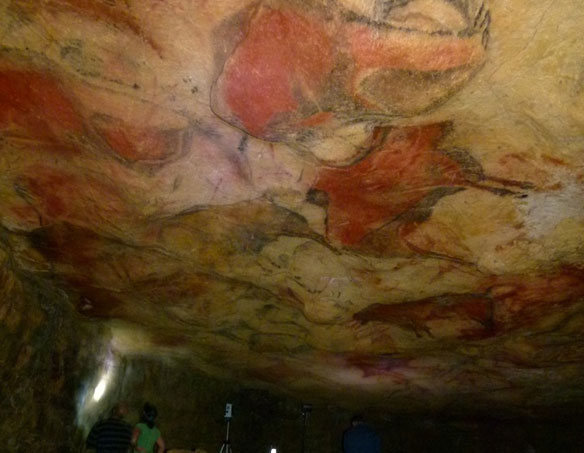
Cuevas de Altamira, Rocky Polychrome Hall in Altamira Cave. Photo source: © MNCN-CSIS, Spain / LiveScience
Excerpts;
At least 14,000 years ago, artists took to Altamira cave in Northern coastal Spain, with charcoal and red pigments, painting bison, deer and their own handprints on the rock walls and ceiling.
The Altamira cave paintings were discovered in 1879, and is located near the town of Santillana del Mar in Cantabria, Spain, 30 km west of the port city of Santander, an historical region of Cantabria situated on the north coast of Spain.
The special relevance of Altamira Cave, comes from the fact that it was the first cave in which prehistoric cave paintings were discovered. When the discovery was first made public, it led to a bitter public controversy between experts which continued into the early 20th century, as many of them did not believe prehistoric man had the intellectual capacity to produce any kind of artistic expression. The acknowledgement of the authenticity of the paintings, which finally came in 1902, changed forever the perception of prehistoric human beings. Wikipedia
The cave with its paintings has been declared a World Heritage Site by UNESCO, and have attracted huge numbers of visitors, 175,000 in 1973, the busiest year on record.
“The caves are inscribed as masterpieces of creative genius and as the humanity’s earliest accomplished art. They are also inscribed as exceptional testimonies to a cultural tradition and as outstanding illustrations of a significant stage in human history.” Unesco
However, this prehistoric art gallery was closed to the public in 2002 after photosynthetic bacteria and fungi were found to be consuming pigments at alarming rates, but plans to reopen the caves could restart the damaging processes and have scientists raising the alarm…

The port city of Santander is the capital of the autonomous community and historical region of Cantabria situated on the north coast of Spain. Photo source: ©© Alvarolg









